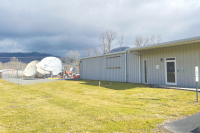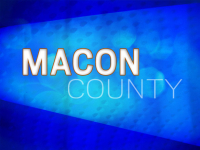Cherokee Trout Hatchery back on track after flash flood
Several raceways were completely submerged in water, hundreds of thousands of trout laid dead on the ground, and the national trout hatchery in Cherokee lost nearly two-thirds of its stock. That was the picture of the hatchery in Cherokee not even one year ago when heavy rains sent a 10-foot wall of water washed over it.
“It was bad. It was real bad,” said Robert Blankenship, manager of the Cherokee fish hatchery and stocking program. “It was devastating to the staff.”
Now, after less than a year, the hatchery is well on its way to recovery. Blankenship estimates that the hatchery will once again be self-sustaining, hatching and raising all its own trout, by late May.
The hatchery plays a critical role in Cherokee’s reputation as prized fishing grounds. The sheer number and size of the trout stocked in Cherokee’s streams and rivers have led to a successful and viable fishing tourism industry — one the tribe was determined to uphold even in the wake of the natural disaster.
During the flood, the hatchery lost more than $160,000 worth of trout and 16 to 18 inches of silt sat at the bottom of each raceway — the long, narrow pools where the trout live. Employees spent the first couple of months collecting the dead trout, scrapping mud, rocks and logs from the raceways and sorting the surviving fish by type and size. Then, it was time to start rebuilding its trout supply. Since it takes a year to raise a mid-sized trout, or two years to raise a trophy trout, the natural disaster could have had long-term repercussions, affecting the number of trout being stocked in Cherokee waters for some time.
Luckily, however, a cooperative arrangement with other nationally certified hatcheries entitled the Cherokee hatchery to any surplus fish or fish eggs that the others might have. Hatchery workers traveled across the U.S. gathering them.
Related Items
Had it not received aid from other national hatcheries, the hatchery in Cherokee would have spent at least two years trying to regain its composure rather than 10 months.
“We’ve had a lot of support and assistance,” Blankenship said.
Eleven national hatcheries in Georgia, Tennessee, Montana, Wisconsin, Arizona, Missouri, Kentucky and West Virginia have been crucial to the recovery.
He estimated that the hatchery has received more than 1.5 million trout and fish eggs from the other hatcheries.
“That is a major part of us trying to rebuild,” Blankenship said. “The more we can get, the more we can put in the river, the more it’s going to help out our program.”
The hatchery must constantly be birthing baby trout to replace the larger fish that it tosses into the river every day to maintain Cherokee’s status in the fishing world.
The tribe’s stocks 30 miles of river and stream on the reservation with 400,000 fish per year.
“For years, people have loved to come to Cherokee for vacation and enjoying the streams and rivers is a major part of their fun,” said Matthew Pegg, executive director of the Cherokee Chamber of Commerce. “The fishing here in Cherokee is some of the best east of the Mississippi and as more people come here to fish the better our hotels, restaurants and other retail shops will do.”
The hatchery currently has about 2 million eggs and baby trout incubating in its smaller indoor raceways and about 800,000 in its larger outdoor raceway. However, six of the usually full raceways sit empty, and the hatchery will not be self-sustaining until next month.
The hatchery is receiving about $100,000 from a federal government relief program and Bureau of Indian Affairs to help with its recovery. A portion of the money will help the hatchery help prevent such a disaster from occurring again by reinforcing already existing water barriers and adding more or larger piping to allow more water to drain away from hatchery lands.
The changes will help “but you will never be able to control Mother Nature,” Blankenship said.
Before Harrah’s Cherokee Casino and Hotel, one of the tribe’s main attractions was trout fishing. The Oconaluftee River has 2.2 miles of water specifically devoted to catch-and-release, fly fishing and hosts numerous tournaments throughout the year.
And now that it has nearly recovered, the hatchery hopes to bring fishing to the forefront once again by keeping the river open year-round and using an electronic system to keep track of and issue fishing permits. Previously, anglers had to receive a handwritten permit each visit — a time-consuming task.
“We are trying to rebuild fishing here in Cherokee,” Blankenship said. “That’s our goal — to make it one of the best family trout fishing destinations.”
This year, the Oconaluftee River will be open year-round for the first time. While it only closed for three weeks each year, the hope is that the prospect of quality, year-round fishing will attract visitors who will then spend money at Cherokee’s various businesses.
“People’s got to buy gas. They got to buy snacks. They’ve got to have a place to stay,” Blankenship said.
Events
• Cherokee's Summer Kickoff Trout Fishing Tournament: April 27, 28, & 29
• Meet Me in the Smokies Fly Fishing Tournament: May 18, 19 & 20
• US Junior National Fly Fishing Championships: June 22, 23 & 24
• Cherokee's Mid Summer Trout Fishing Tournament: July 13, 14 & 15
• Cherokee's End of Summer Trout Fishing Tournament: September 7, 8 & 9
• Rumble in the Rhododendron Fly Fishing Tournament: November 2, 3 & 4
• How long is your trout?
ongoing - Bring your trout to the Cherokee Welcome Center and have it measured for the weekly contest which will run from Saturday to Sunday. You must present a hotel or camping receipt to qualify for this contest.
The Catch & Release water is excluded.
For more information on these events, visit www.fishcherokee.com









